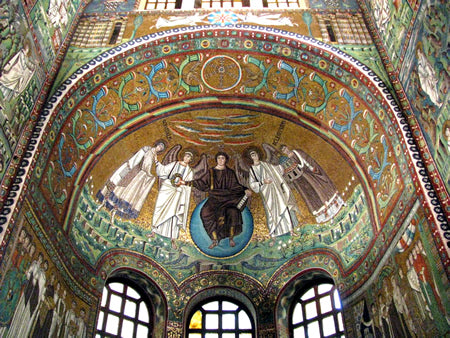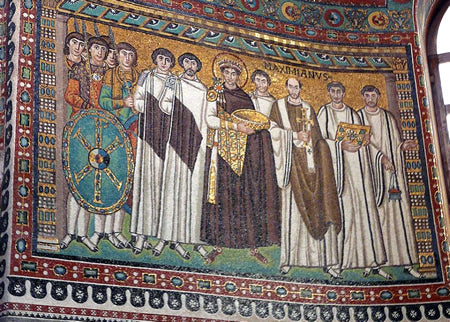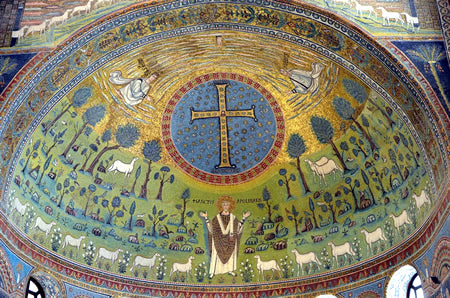The Mosaic and Byzantine Painting
The mosaics and Byzantine iconographic paintings prior to the iconoclastic crisis are scarce, most sacred images have been destroyed, as well as a large number of secular examples. Nonetheless, what is preserved allows us to understand the guidelines and characteristics followed by the painting and mosaic of those centuries.
Byzantine works are realistic representations with very rich chromatism. They use a stylistic language that is characteristic of Roman antiquity and classical Greece. Somehow, the aesthetic proposal is a rudimentary and Eastern version of the Renaissance that would reach the West 8 centuries later.
Notable Byzantine Works
- Mosaics in San Vitale in Ravenna
In Italy, the most preserved examples of ecclesiastical mosaic from the 6th and 7th centuries can be found. One of the most important examples is the decoration of the San Vitale in Ravenna church, where the apsidal mosaic and the pictorial representations of Justinian and Theodora stand out.
The central scene is presided over by Christ Pantocrator, dressed in purple (the color representative of the suffering he endured on the cross), in his left hand he holds the scroll of the Torah, symbolizing the fulfillment of the Jewish tradition in Christ. In his right hand, he passes a crown to San Vitale, who has his name written at the top, just like Ecclesio, the bishop who ordered the construction of this church and who in turn holds a model of it in his hand. Two archangels stand by their sides, encouraging them. Below Christ, four rivers representing paradise can be seen. The scenes display a certain naturalism, are schematic, and use simplified symbols (hieratic).
-

"Pantocrator" in San Vitale in Ravenna
Over the golden and green background, the mosaic of Justinian is superimposed, accompanied by his retinue on the right and clergy on the left. He carries a large gold plate in his hands, which, simulating the epiphany of the Magi, is offered to the Christ Pantocrator of the central apse. The imperial guard carries a shield decorated with religious symbols "XP" (chi-rho) and on the left hand, the clerics are led by Maximilian carrying a cross.
-

"Justinian" in San Vitale in Ravenna
The characters are depicted in a flat manner, which greatly emphasizes the symbolic interest of the work: the union between ecclesiastical and civil power in the emperor.
The opposite panel is the mosaic of Theodora, empress and wife of Justinian. Alongside her retinue of men and women in a palatial setting, she also offers Christ a gold chalice. The figures are once again flat and lack three-dimensionality.
-

"Teodora" in San Vitale in Ravenna
- Mosaics in the Basilica of Sant'Apollinare in Classe
Another of the main examples of Byzantine mosaic from the 6th century is the Basilica of Sant'Apollinare in Classe. The central (apse) mosaic consists of a Pantocrator in a medallion with a cross. At the top, the golden background with images of the Transfiguration with the prophet Elijah and Moses, and the hand of God pointing to the cross can be seen. Sant'Apollinare is depicted praying, in a landscape filled with trees and twelve lambs at the sides, alluding to the twelve apostles.
-

"Apse of the Basilica of Sant'Apollinare in Classe"
- Mosaic in the Basilica of Saint Agnes Outside the Walls
Created in the 7th century, the mosaic stands out as the central apse of the Basilica of Saint Agnes Outside the Walls, in Rome. Saint Agnes is positioned at the center of the image against a golden background with abstract textures. At her feet, two flames symbolize martyrdom. Above her head, two blue stripes represent the starry sky and clouds, from which the hand of God emerges, holding the crown of her martyrdom. Beside her is Pope Honorius I holding a model of the church and to her left is Pope Symmachus, who opposed the unification of political and religious powers (Caesaropapism), prevailing since Constantine I.
-

"Mosaic in the Basilica of Saint Agnes Outside the Walls"
- Paintings in the Monastery of Saint Apollo at Bawit
The last and unique example referring to Byzantine mural painting before the iconoclastic controversy is the apse of the Monastery of Saint Apollo at Bawit, in Egypt. The fresco shows figurative simplicity and is decorated in two overlapping phases: In the upper part, Christ Pantocrator within an almond-shaped ellipse (mandorla), flanked by the archangels Michael and Gabriel. The lower phase represents the Virgin enthroned with the child on her lap, flanked by the figures of the twelve apostles and two local saints. The faces exhibit a type of linear painting with the use of vivid contrasting colors.
-

"Paintings in the Monastery of Saint Apollo at El Bawit"
The Byzantine Style
In conclusion, although scarce, the sacred images that remained after the iconoclastic crisis have allowed for the determination of some of the preferred guidelines by early Byzantine authors. The plastic simplicity and thematic complexity are the foundation of the Byzantine style, which aspired through its majesty, to return to classical magnificence while at the same time innovating it.
↑Back to top
0 products
